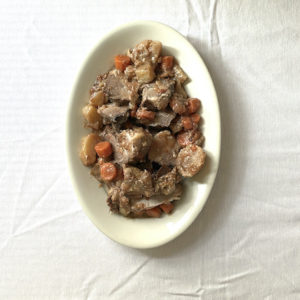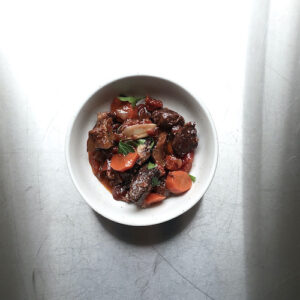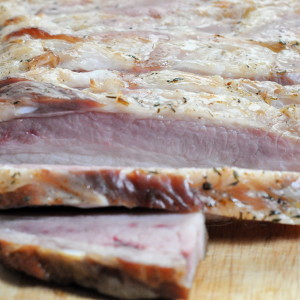Pork Parmesan Meatballs
Many years ago we belonged to a meat CSA. Once monthly, I drove to beautiful home in Berkeley, where I fetched a box containing the finest meat we’ve ever eaten.
Alas, we left the CSA. Members had to opt for specific monthly amounts: 11 pounds, 17 pounds, or another, higher number I can’t recall. For a household of two, 11 pounds was a reasonable choice, but it meant receiving one superb roast, with the remaining weight made up in one-pound packets of ground chicken, pork, beef, and goat. This grew tiresome as a steady diet, even after exploring every possible variation on mince. Reluctantly, we let our membership lapse.
Eventually our fondness for all things burgeresque reasserted itself. In the interim, the slider craze hit the country. Suddenly something I’d been long been doing chez IK–making little hamburgers–was, well, a thing. Only out in the world, restaurants were adding fancy toppings and baking little buns, trying to earn a buck off the simple premise of making a smaller hamburger.
Next came the meatball craze, affirming once and for all the human fascination with smallness.
Nobody’s disputing the appeal of three mini-burgers or a school of meatballs on your plate (a group? a flight? a murder of meatballs?). But why pay extra for it? Do you know what to do with octopus? Pay somebody to cook that.
Why downsize ground meat, anyway? Tweeness aside, more practical considerations assert themselves here, namely, Becker Muscular Dystophy. It’s a lot easier for John to manage smaller bits of food than big ones. So it was I fell into the habit of making “burgerlets”. I have never cottoned to “slider”, a term I find annoyingly commercial. I am not running a restaurant. I’m cooking dinner.
For whatever reason, burgerlets chez IK are most often made from ground pork or chicken, with lamb making an occasional appearance. Ground beef, a rare purchase, is destined to become a full-sized, completely realized burger.Please don’t demand a coherent rationale for this. I don’t have one.
Pork Parmesan Meatballs rolls burgerlets a little smaller. Don’t eat pork? Substitute ground chicken. This recipe is in fact a riff off Diana Henry’s Chicken, Spinach, And Cheese Polpette, from her worthy A Bird In The Hand.
Ground meats can be nasty bacterial carriers. Be vigilant about cleanliness. Wash your equipment and hands with hot, soapy water. Rub a cut lemon over the board and your hands. I sometimes rub that lemon over my sink and sponge, too.
This recipe calls for some fiddly prep–sautéeing the onion and garlic, fussing with spinach. Taking these steps means a finished dish with greater finesse, but the rushed cook could mince a little scallion while decreasing or omitting the garlic. As for the spinach, cooks wanting to skip the pre-cooking step could finely chop it raw, then toss it into the meat as is. Or eliminate it, adding minced fresh parsley. I do this all the time. No spinach? Feeding spinach haters? Fresh sage–don’t overdo it–or thyme work beautifully here. Know that both these herbs freeze nicely when bought fresh.
Do season aggressively with salt, pepper, and lemon juice. Otherwise, blandness.
Pork Parmesan Meatballs
Adapted from Diana Henry’s Chicken Polpette recipe in A Bird In The Hand
Serves 4 as an appetizer or 2-3 as a meal
cooking time: approximately 40 minutes
1 pound ground pork
2 tablespoons minced parsley
2 garlic cloves, peeled and minced
1/2 shallot, small onion, or scallion, peeled, minced. If using scallion, trim tip and use white and light green parts
1 tablespoon parmesan cheese, grated (NOT the pencil shavings in the cardboard tube)
One medium or large lemon, preferably organic. If not, scrub well. You’ll need the zest and the juice. (See note.)
approximately 5-6 ounces spinach, well-washed, larger stems removed
3-4 tablespoons olive oil
Generous teaspoon salt and pepper
Note: If using ground chicken, you’ll need to add two tablespoons breadcrumbs or matzo meal, as ground chicken tends to be watery.
Heat 2 tablespoons olive oil in a large skillet over medium-low heat. Add the garlic and shallots (or other onions). You want them to soften but not brown. This will take a few minutes. Once they have softened, remove from the pan to a bowl and allow to cool.

Add the spinach to the same pan with a couple tablespoons of water. While Henry suggests cooking it in clean skillet, I have my limits–and no dishwasher. The spinach needs to wilt without drying out or crisping, so lower the heat if necessary. It will shrink dramatically.

Once the spinach is shrunken and velvety looking, remove from the pan to a colander. Allow to cool enough to handle, then squeeze moisture from it and chop finely.

In a large bowl, mix all ingredients with the pork.

Meatballs are easier to form if you work with wet hands. Place a small, shallow bowl of water nearby, along with a cookie sheet for the meatballs.

Meatballs may be whatever size you wish. Mine were roughly ping-pong ball-sized, and I got 22 meatballs from one pound of pork. Meatballs are about patience and dexterity. Neither are qualities I excel in.
Once your meatballs are ready, you can chill them for half an hour, which lets them find themselves a bit, or you can cook them immediately.
I browned the meatballs on the stovetop, finishing them in the oven.
Preheat the oven to 275F.
Depending on your pot and the size of your meatballs, you may need to cook in batches, as I did. Film a skillet with olive oil; the pan size is less important than not crowding the meatballs, which need room to cook rather than steam.

Turn the burner to medium heat. Brown the meatballs on a couple “faces” at least three minutes a side before transferring to a sheet pan and tucking into the oven, where they will finish cooking in about ten minutes. Not sure they’re done? Cut into one. It should be brown all the way through, without a trace of pink.
You may wish to drain the meatballs on paper towels.
Meatballs are delicious hot or at room temperature. We like to eat these as pictured, with salad veggies and tortillas. John likes them smeared with Amora mustard.
Not pictured: embarrassing amounts of mayonnaise prinked up with Sriracha sauce. Some people really like eating meatballs this way. (Cough).
Leftovers would make a fine lunch. If there are any.
Notes:
About zesting lemons: I struggle with graters, which always seem to trap the fruit zest in their sharp little teeth. I prefer to peel citrus zest with a vegetable peeler, then mince it finely with a sharp knife. Do whatever feels best.
You may also cook meatballs in the oven. Preheat it to 350 F. Place meatballs on a cookie sheet. Bake for 25 minutes. Slice one to ensure they are cooked through.





